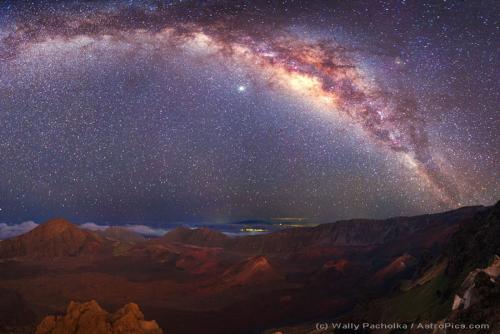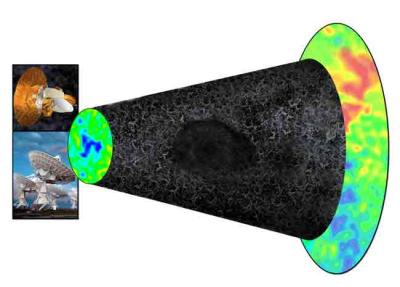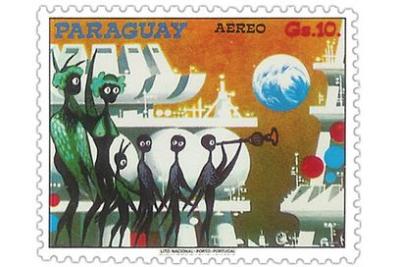Topic: Universe - on June 27, 2013 at 2:13:00 PM CEST
PayPal plant Bezahldienst für Weltall
Paypal kündigte am Donnerstag den Start von Paypal Galactic an. Am Forschungsprojekt arbeiten neben PayPal auch SETI und die privaten Raumfahrtunternehmen Virgin Galactic und Space X. Ziel ist das Entwickeln eines Bezahlsystems für das Weltall.
Der Online-Bezahldienst PayPal hat am Donnerstag ein etwas kurioses Vorhaben angekündigt. Gemeinsam mit den Forschern von SETI sowie dem Interessenverband Space Tourism Society, dem Virgin Galactic und Space X anggehören, startet das Unternehmen die Initiative PayPal Galactic. Dabei soll erforscht werden, wie Bezahlung im Weltall funktionieren soll.
... Link (0 comments) ... Comment
Topic: Universe - on January 28, 2009 at 1:36:00 PM CET
Have you ever seen the band of our Milky Way Galaxy?
In a clear sky from a dark location at the right time, a faint band of light becomes visible across the sky. Soon after your eyes become dark adapted, you might spot the band for the first time. It may then become obvious. Then spectacular. One reason for a growing astonishment might be the realization that this fuzzy swath contains billions of stars and is the disk of our very own spiral galaxy

... Link (0 comments) ... Comment
Topic: Universe - on November 30, 2008 at 1:18:23 PM CET
"78 Billion" -A 'Hubble' Video: Journey to the Beginning of Time
It helps to put things in perspective here on our frenetic little planet with a look at this extraordinarily powerful and moving video of the Hubble Space Telescope mapping of the Universe, whose known size is 78 billion light years across.
... Link (0 comments) ... Comment
Topic: Universe - on August 3, 2008 at 8:29:00 PM CEST
Total solar eclipse as seen from an aircraft
... Link (0 comments) ... Comment
Topic: Universe - on August 3, 2008 at 8:25:00 PM CEST
Solar Eclipse 2008

... Link (0 comments) ... Comment
Topic: Universe - on December 27, 2007 at 1:26:00 PM CET
Largest diamond in galaxy predicts future of solar system
Astronomers discovered the largest diamond of all times in space. The weight of the precious stone reportedly makes up ten billion trillion trillion carats or five million trillion trillion pounds).
The space diamond is virtually an enormous chunk of crystallized carbon, 4,000 kilometers in diameter. The stone is located at a distance of 50 light years from Earth, in the Constellation Centaurus.
... Link (0 comments) ... Comment
Topic: Universe - on December 22, 2007 at 8:00:00 PM CET
At least NORAD is tracking Santa Claus
In light of this week’s government-level UFO banter in Tokyo, it’s kinda fitting that the 100th Monkey Effect was conceived in Japan.
You remember that one, right? Scientists studying simian behavior on Koshima Island in the 1950s supposedly noticed how an 18-month old female monkey started rinsing off sweet potatoes in a stream before eating them.
She teaches a few adults to emulate her; more join in. Next thing you know, the numbers indulging this new activity reach a critical mass of, say, 100, and — bingo — the entire population is washing its sweet potatoes.
... Link (0 comments) ... Comment
Topic: Universe - on December 14, 2007 at 2:03:00 PM CET
Top Ten Astronomy Pictures of 2007
Astronomy is arguably the most beautiful of the sciences. I’m biased, of course, but it’s nearly impossible to gaze upon a picture of a galaxy, a moon, a nebula, and not see in it something compellingly artistic. Sometimes it’s the color, sometimes the shape, and sometimes it’s the knowledge that we can understand the subject of the picture itself.

... Link (0 comments) ... Comment
Topic: Universe - on October 26, 2007 at 10:17:00 AM CEST
Hundreds of Black Holes Found
Astronomers have unmasked hundreds of black holes hiding deep inside dusty galaxies billions of light-years away.
The massive, growing black holes, discovered by NASA's Spitzer and Chandra space telescopes, represent a large fraction of a long-sought missing population. Their discovery implies there were hundreds of millions of additional black holes growing in our young universe, more than doubling the total amount known at that distance.
... Link (0 comments) ... Comment
Topic: Universe - on September 7, 2007 at 12:16:00 PM CEST
Hubble and Spitzer Space Telescopes Find "Lego-Block" Galaxies in Early Universe
NASA's Hubble and Spitzer Space Telescopes have joined forces to discover nine of the smallest, faintest, most compact galaxies ever observed in the distant universe. Blazing with the brilliance of millions of stars, each of the newly discovered galaxies is a hundred to a thousand times smaller than our Milky Way Galaxy.
"These are among the lowest mass galaxies ever directly observed in the early universe," says Nor Pirzkal of the Space Telescope Science Institute and the European Space Agency in Baltimore, Md.

... Link (0 comments) ... Comment
Topic: Universe - on August 26, 2007 at 11:53:00 AM CEST
Astronomers find a hole in the universe
Astronomers have stumbled upon a tremendous hole in the universe. That's got them scratching their heads about what's just not there. The cosmic blank spot has no stray stars, no galaxies, no sucking black holes, not even mysterious dark matter. It is 1 billion light years across of nothing. That's an expanse of nearly 6 billion trillion miles of emptiness, a University of Minnesota team announced Thursday.

... Link (0 comments) ... Comment
Topic: Universe - on June 30, 2007 at 12:30:00 AM CEST
The Stamp Collector's Guide to the Galaxy
Ufology and philately share at least one thing: a passion for collecting, whether it be news clippings on unexplained cases or first day covers. From the mid-1970s onwards ufologists have had plenty of opportunities to combine these passions in the form of flying-saucer stamps.

... Link (0 comments) ... Comment










